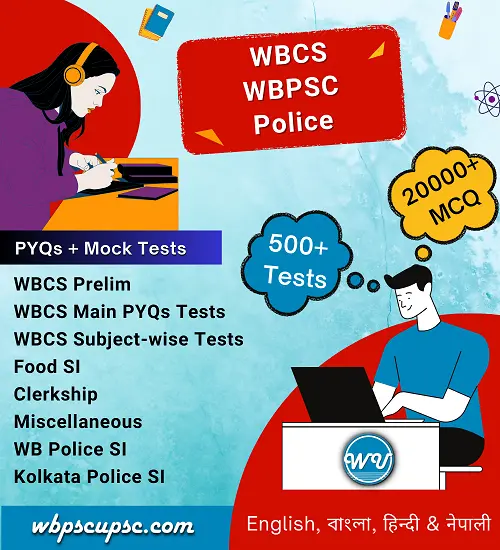Contents

Sepoy Revolt questions
WBCS Main Question Paper – 2023
5. Fort William College was founded in
(A) 1800
(B) 1820
(C) 1850
(D) 1900
12. Who was associated with the ‘Sunset Law‘?
(A) Lord Lytton
(B) Lord Ripon
(C) Lord William Bentinck
(D) Lord Cornwallis
14. Who was the first Indian ruler to accept the Subsidiary Alliance?
(A) The Nawab of Bengal
(B) The Nizam of Hyderabad
(C) The Nawab of Awadh
(D) Peshwa Balaji Baji Rao
15. Which Governor General introduced the ‘Doctrine of Lapse‘?
(A) Lord Cornwallis
(B) Lord Dalhousie
(C) Lord Wellesley
(D) Lord Ripon
21. Who started the Brahmo Samaj Movement?
(A) Dayananda Saraswati
(B) Raja Rammohan Roy
(C) Swami Vivekananda
(D) Mahadev Govind Ranade
22. The Ryotwari System was first introduced in
(A) Bengal
(B) Delhi
(C) Madras
(D) Gujarat
29. Who appointed the Amini Commission?
(A) Lord Cornwallis
(B) Lord Dalhousie
(C) Lord Warren Hastings
(D) Lord Minto
47. Nadir Shah invaded India in
(A) 1708
(B) 1688
(C) 1739
(D) 1750
49. Who was the leader of Santhal Rebellion?
(A) Sindhu Murmu
(B) Jyotiba Phule
(C) Birsa Munda
(D) Vishnucharan Biswas
69. Sati Act was passed in the year
(A) 1856
(B) 1829
(C) 1729
(D) 1929
70. Third battle of Panipat took place in
(A) 1761
(B) 1740
(C) 1770
(D) 1707
90. The signatories of the Treaty of Bassein (1802) were the English East India Company and
(A) the Sikhs
(B) the Marathas
(C) Nizam of Hyderabad
(D) Tipu Sultan
92. Hindu College was established in
(A) 1817
(B) 1812
(C) 1858
(D) 1885
WBCS Main Question Paper – 2022
9. The Hindu College was founded in the year
(A) 1818
(B) 1816
(C) 1817
(D) 1819
29. Nawab Alivardi Khan was the grandfather of
(A) Shuja ud Daulah
(B) Siraj ud Daulah
(C) Sarfraz Khan
(D) Mir Qasim
32. The Battle of Plassey was fought in
(A) 1756
(B) 1757
(C) 1780
(D) 1790
37. The Tattwabodhini Patrika was founded by
(A) Raja Rammohan Roy
(B) Pandit Iswar Chandra Vidyasagar
(C) Debendranath Tagore
(D) Keshab Sen
43. The Permanent Settlement was passed in the year
(A) 1803
(B) 1813
(C) 1793
(D) 1834
63. Raja Rammohan Roy was the founder of
(A) Bahujan Sabha
(B) Brahmo Sabha
(C) Jatiyo Sabha
(D) Lok Sabha
65. The Battle of Buxar took place in the year
(A) 1765
(B) 1764
(C) 1795
(D) 1800
69. The Hindoo Patriot was edited by
(A) Manmohan Ghosh
(B) Harish Chandra Mukherjee
(C) Debendranath Tagore
(D) Acharya Binoba Bhave
98. Satidaha Bill was passed in the year
(A) 1830
(B) 1829
(C) 1831
(D) 1832
199. The first passenger train in India ran between
(A) Bombay and Thane
(B) Bombay and Pune
(C) Bombay and Nasik
(D) Calcutta and Serampore
WBCS Main Question Paper – 2021
5. Which of the following statements is not true of the Permanent Settlement?
(A) The settlement was introduced initially as a decennial settlement
(B) It gave rise to a market in land
(C) It resulted in pauperisation of the peasantry
(D) None of the above
11. According to which treaty were Tipu’s children held in Calcutta as security pending payment of compensation to the Company?
(A) Treaty of Madras
(B) Treaty of Mangalore
(C) Treaty of Seringapattanam
(D) Treaty of Trichinopolly
16. Which treaty brought the second Anglo-Mysore war to a close?
(A) Madras
(B) Seringapattanam
(C) Trichinopolly
(D) Mangalore
18. Under the Ryotwari system, after how many years could there be a reassessment of revenue demand?
(A) 10 years
(B) 20 years
(C) 30 years
(D) Never
21. Of the death of which Maratha leader was it said, “with him departed all the wisdom in the Maratha State”?
(13 March 1800)
(A) Peshwa Madhav Rao
(B) Mahadaji Sindhia
(C) Nana Fadnavis
(D) Yashwant Rao Holkar
29. Who among the following did not benefit territorially from the Treaty of Seringapatam?
(18 March 1792)
(A) The Company
(B) Hyderabad
(C) The Marathas
(D) Bhonsle of Berar
42. Which of the following settlements was a result of the Holt Mackenzie surveys of the 1820s?
(UP, NW province, Central, Punjab)
(A) Taluqdari system
(B) Ryotwari system
(C) Anganwadi system
(D) Mahalwari system
45. In which year was Satara, the family seat of the house of Shivaji, annexed by the British?
(A) 1835
(B) 1842
(C) 1848
(D) 1854
76. Who was the only Governor-General of Bengal to be appointed twice to the office?
(A) Lord Clive
(B) Lord Cornwallis
(C) Lord Wellesley
(D) Lord Bentinck
84. Who was the only Governor-General Bengal to be impeached by the British Parliament
(1787 – 1795)
(A) Robert Clive
(B) Warren Hastings
(C) Lord Wellesley
(D) None of the above
92. In which year was the Treaty of Salbai signed?
(A) 1776
(B) 1782
(C) 1793
(D) 1802
93. Why did Mir Qasim shift his capital from Murshidabad to Munger?
(A) Murshidabad was easily accessible from Calcutta by the riverine route.
(B) The defensive fortifications of Murshidabad were inadequate given Company’s fire power.
(C) It was easier to receive military support from Awadh and North India undetected.
(D) All of the above
106. How did the British victory in Bengal help them prevail over the French in the Carnatic?
(A) Troops and resources from Bengal were made available in the Carnatic.
(B) Sir Eyre Coote, despatched by Clive, inflicted a crushing defeat on the French.
(C) Both (A) and (B)
(D) Neither (A) nor (B)
121. Which of the following was not true of the Treaty of Madras, 1769?
(A) It was forced by Haidar after a victorious campaign against the combined forces of the Madras Council and the Nizam of Hyderabad.
(B) It entailed a defensive alliance between Mysore and the Company.
(C) The Company was exempted from the compulsion of defensive alliance if Mysore went to war with Hyderabad.
(D) None of the above
127. Where among the following places was Permanent Settlement not introduced?
(1 May 1793)
(A) Bengal
(B) Bihar
(C) Assam
(D) Punjab
151. By which treaty was Gulab Singh given the kingdom of Jammu and Kashmir?
(26 Dec 1846)
(A) Treaty of Amritsar
(B) Treaty of Lahore
(C) Treaty of Bhairowal
(D) Treaty of Jullundar
159. With the revenue settlement of which region was Montsuart Elphinstone associated?
(1818)
(A) Punjab
(B) Agra
(C) Bombay
(D) Awadh
162. Who was the editor of the Rast Goftar?
(A) Amir Ali
(B) Sir Syed Ahmed Khan
(C) Maulana Azad
(D) Dadabhai Naoroji
167. Which of the following were not coveted by Tipu Sultan?
(A) Coorg
(B) Guntoor
(C) Calicut and Travancore
(D) None of the above
193. Which of the following was not true of the Treaty of Surat?
(A) It was concluded between Raghunath Rao and the Calcutta Council of the East India Company.
(B) The Company pledged military assistance to restore Raghunath Rao to power.
(C) The Company was to gain Thana, Salsette and Bassein.
(D) The Company was to receive revenue collected from Surat and Broach.
198. Which Governor-General of Bengal set up the General Committee of Public Instruction to supervise Company’s expenditure in the realm of education?
(1923)
(A) Lord Hastings
(B) Lord Amherst
(C) Lord Bentinck
(D) Charles Metcalfe
WBCS Main Question Paper – 2020
- Which of the following statements about Henry Louis Vivian Derozio is incorrect?
(Hindu College, Kolkata)
(A) He was born in Calcutta in 1809.
(B) He taught at the Sanskrit College between 1826-1830.
(C) He died of Cholera at the age of 22.
(D) His followers were known as Derozians.
- The Asiatic Society of Bengal was founded by
(1784)
(A) Ram Mohan Roy
(B) William Jones
(C) W.W. Hunter
(D) William Bentinck
- The Peshwa accepted the Subsidiary Alliance with the British by
(1802)
(A) Treaty of Purandhar
(B) Treaty of Bassein
(C) Treaty of Salbai
(D) Treaty of Surji Arjangaon
- The Revolt of 1857 did not acquire much intensity in
(A) Delhi
(B) Awadh
(C) Bombay
(D) The Chambal region
- Permission to the British to establish their trading centre at Surat was given by the Mughal Emperor
(1613)
(A) Babur
(B) Humayun
(C) Akbar
(D) Jahangir
- The administrative consequence of the Revolt of 1857 was the transfer of power from
(A) East India Company to the British Crown.
(B) British Crown to the East India Company.
(C) East India Company to the Governor General.
(D) British Crown to the Board of Directors.
- The English East India Company ceased to be a trading company by which of the following legislations?
(A) Pitts India Act of 1784
(B) Charter Act of 1833
(C) Charter Act of 1813
(D) Government of India Act, 1858
- The revolt of the Khasis against the British was led by
(U Tirot Sing Syiem)
(A) Surendra Rai
(B) Titu Mir
(C) Birsa Munda
(D) Utkot Sing
- Which of the following reform movements was the first to be started in the 19th Century?
(20 Aug 1828)
(A) Prarthana Samaj
(B) Arya Samaj
(C) Brahmo Samaj
(D) Rama Krishna Mission
- Which European power was the last to reach India?
(A) Portuguese
(B) The Dutch
(C) British
(D) French
- The treaty of Seringapatam is associated with the end of
(A) Second Anglo – Maratha war
(B) Third Anglo – Maratha war
(C) Third Anglo – Mysore war
(D) Fourth Anglo – Mysore war
- Vasco da Gama, the sailor was a
(A) Portuguese
(B) American
(C) German
(D) Italian
- Universities in the Presidency towns in India were established in the year
(A) 1857
(B) 1858
(C) 1900
(D) 1909
122. Tobacco was introduced into India by the
(A) Chinese
(B) Portuguese
(C) English
(D) French
123. The modern iron and steel industry in India has its beginning in 1870 when Bengal Iron Works Company was established in
(A) Kulti
(B) Bishnupur
(C) Cossipore
(D) None of the above






